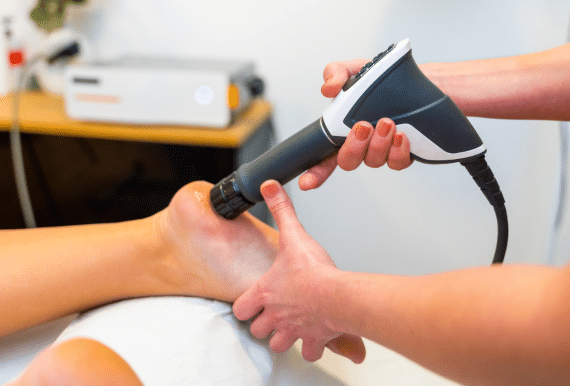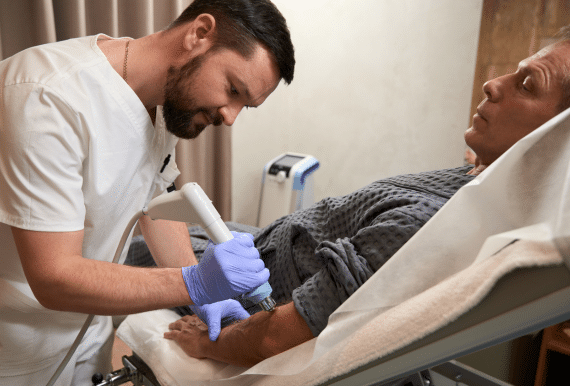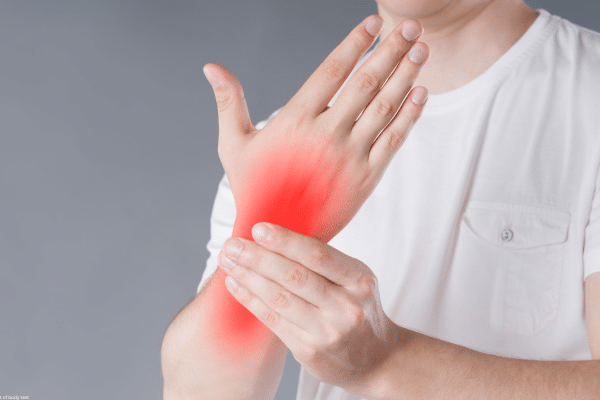Introduction


What Is Shockwave Therapy?
Shockwave therapy, also known as extracorporeal shockwave therapy (ESWT), involves using high-energy sound waves to stimulate healing in damaged tissues. Originally developed to break down kidney stones, this technique has been adapted for treating chronic pain and soft tissue injuries.
It is particularly effective for conditions such as plantar fasciitis, tennis elbow, shoulder tendinitis, and calcific deposits.
How Does Shockwave Therapy Work?
During a shockwave therapy session, a device is used to deliver focused acoustic waves to the affected area. These waves penetrate deep into the tissues, increasing blood flow, promoting cell regeneration, and stimulating the body’s natural healing processes. The therapy also helps break down scar tissue and calcifications, which can impede recovery.
Key Benefits of Shockwave Therapy:
- Non-Invasive Treatment: No surgery or injections are required, making it a safer option with minimal risk.
- Accelerated Healing: By stimulating blood flow and cell repair, shockwave therapy can speed up the recovery process.
- Pain Relief: Many patients experience significant pain relief after just a few sessions.
- Versatile Applications: Effective for a wide range of musculoskeletal conditions, including those that have not responded to other treatments.
Why Choose Shockwave Therapy?
Shockwave therapy offers several advantages over traditional treatment methods, particularly for chronic pain conditions that are difficult to treat. Here’s why it might be the right choice for you:
1. Effective for Chronic Conditions
Many patients turn to shockwave therapy after other treatments, such as physical therapy, medications, or injections, have failed to provide lasting relief. It is particularly beneficial for chronic conditions like tendinitis, where it helps to break the cycle of inflammation and pain.
2. Minimal Side Effects
Unlike medications that can have systemic side effects, shockwave therapy is localized, meaning the effects are concentrated in the treatment area. Common side effects are mild and may include temporary discomfort or swelling, but these typically resolve quickly.
3. Non-Invasive with No Downtime
For those looking to avoid surgery or injections, shockwave therapy is an excellent alternative. Since the procedure is non-invasive, there’s no downtime required, allowing you to return to your normal activities immediately.
4. Promotes Long-Term Healing
Shockwave therapy doesn’t just mask the symptoms—it addresses the underlying cause of the pain by promoting natural tissue repair. This means that the benefits of the treatment can be long-lasting, reducing the likelihood of the condition recurring.
Case Study from Physio Pros Bolton
Patient: Sarah T, 45-year-old runner
Condition: Chronic plantar fasciitis
Location: Bolton
Sarah, an avid runner, had been battling chronic plantar fasciitis for over a year. Despite trying various treatments like rest, orthotics, and anti-inflammatory medications, she found only temporary relief. Her heel pain, rated at 8/10, was disrupting her active lifestyle.
Treatment Plan
Therapy: Shockwave Therapy
Sessions: 6 (once a week)
Session Duration: 20 minutes
Sarah underwent six shockwave therapy sessions at Physio Pros, designed to stimulate healing and reduce pain. The therapy was non-invasive, and Sarah was able to continue her daily activities with no downtime.
Results
Pain Reduction:
- Before Treatment: 8/10
- After 3 Sessions: 5/10
- After 6 Sessions: 2/10
After completing the sessions, Sarah’s pain significantly decreased, allowing her to resume light jogging and fitness activities. Three months post-treatment, she maintained a minimal pain level of 1-2/10 and returned to her regular running routine.
Conclusion
Sarah’s case demonstrates the effectiveness of shockwave therapy for chronic plantar fasciitis, especially when traditional treatments fall short. Physio Pros offers this innovative therapy to help patients like Sarah achieve lasting pain relief and regain their active lifestyles.
What to Expect During Treatment
A typical shockwave therapy session lasts about 15-20 minutes. The therapist will apply a gel to the treatment area to enhance the transmission of sound waves, followed by the application of the shockwave device. Most patients require a series of treatments, usually spaced one week apart, to achieve optimal results.
Post-Treatment Care:
- Hydration: Drink plenty of water to help your body flush out any debris from the treated tissues.
- Activity Modification: Avoid strenuous activities for a few days post-treatment to allow the area to heal properly.
- Follow-Up: Your therapist will guide you on any additional steps, including exercises or additional sessions, based on your progress.
Conclusion
Shockwave therapy is a powerful and versatile treatment option for individuals struggling with chronic pain or slow-healing injuries. Its ability to promote natural healing, provide pain relief, and do so without the need for invasive procedures makes it an attractive option for many patients. If you’re considering shockwave therapy, consult with our expert team at Physio Pros in Bolton & Oakville to see if this innovative treatment is right for you.













